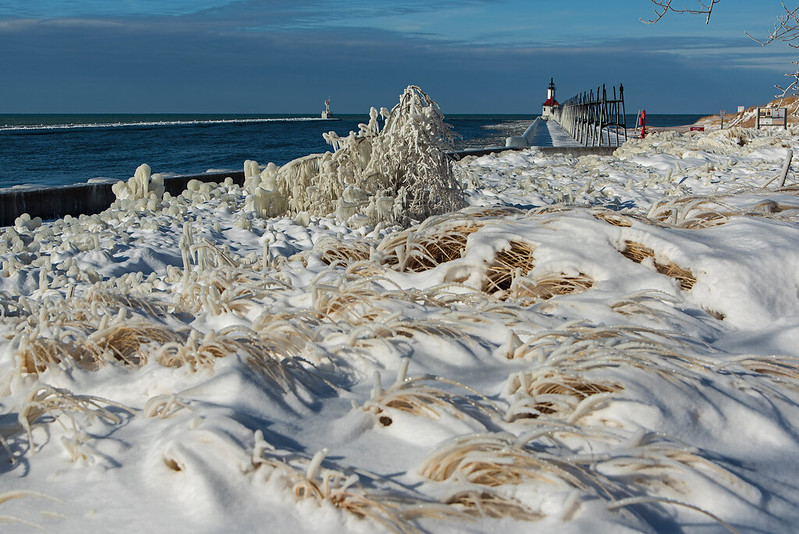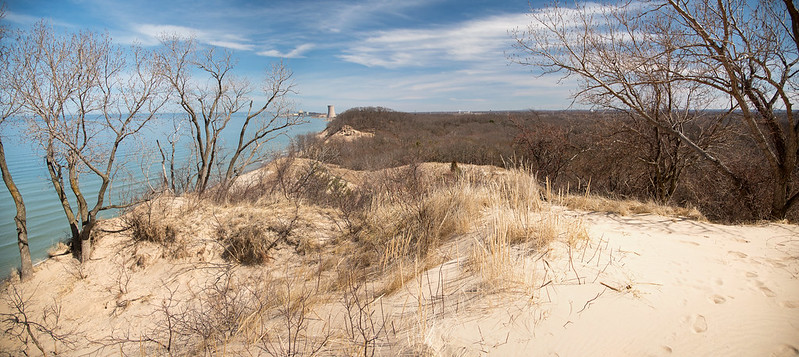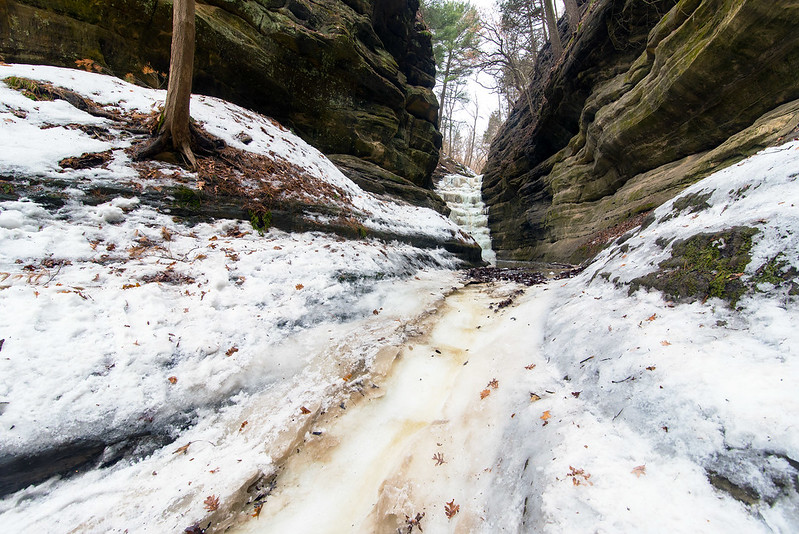
Ice Around the Pier

The "Hoodoos" of St. Joseph Michigan

The Ice is Beginning to Form

The new year brought some frigid weather to the southern Lake Michigan area, enough to begin the creation of some thick ice on the pier and catwalk of the St. Joseph, Michigan lighthouse. Typically, the ice begins to form much earlier in the season - sometimes in late November - but this winter, conditions weren't right until now.
Conditions include very cold temperatures, winds high enough to churn up waves that crash into the pier and lighthouse, and a liquid lake (not frozen yet) so waves can build up. A layer of ice on the lake prevents the water from splashing up, so later in the winter when the lake usually freezes over, ice rarely builds on the lighthouses.

While the ice hasn't yet covered the lighthouse, it is beginning to freeze the surfaces of the pier, railings, and catwalk. The ice on the railings is already about two feet thick may continue to build depending on how conditions are in the future.
Many years ago, winters along the Lake Michigan shoreline were generally lonely, very few people ventured to view the lighthouses or ice along the shore. In recent years, however, crowds of people brave the cold weather to experience the ice formations. As long as the everyone keeps off the ice, it's a great thing to see.
Autumn Hike on the Boardwalk
 This Fall season was relatively warm and dry, so the thought was that the leaves would drop early and without much color. As it turns out, the color was great, it was just delayed a few weeks. Visiting the Chellberg Farm trails at the Indiana Dunes National Park has become a tradition in the Fall, and it never disappoints. This area has scores of maple and beech trees that turn golden in autumn, and the rolling landscape provides the perfect setting for a hike.
Boardwalks and stairs provide relatively easy access through the deep gullys of this area. Even in the rain, hikers can enjoy the landscape without too much mud or overflow of streams.
This Fall season was relatively warm and dry, so the thought was that the leaves would drop early and without much color. As it turns out, the color was great, it was just delayed a few weeks. Visiting the Chellberg Farm trails at the Indiana Dunes National Park has become a tradition in the Fall, and it never disappoints. This area has scores of maple and beech trees that turn golden in autumn, and the rolling landscape provides the perfect setting for a hike.
Boardwalks and stairs provide relatively easy access through the deep gullys of this area. Even in the rain, hikers can enjoy the landscape without too much mud or overflow of streams.
 On the day of this hike the parking area was overflowing with cars, and the remote lot was being used. Surprisingly, these trails were almost empty; I wonder if visiters only knew about the short trail near the sugar shack and behind the farmhouse. Venturing past the barns and field, one finds the trail that wanders through these rolling, wooded dunes. There are a few trails that total about four miles (maybe more if you wander off toward other parts of the park), but this trail is about a mile loop. It's well worth exploring any time of year, but especially in the Fall.
On the day of this hike the parking area was overflowing with cars, and the remote lot was being used. Surprisingly, these trails were almost empty; I wonder if visiters only knew about the short trail near the sugar shack and behind the farmhouse. Venturing past the barns and field, one finds the trail that wanders through these rolling, wooded dunes. There are a few trails that total about four miles (maybe more if you wander off toward other parts of the park), but this trail is about a mile loop. It's well worth exploring any time of year, but especially in the Fall.
Autumn Gold

Walking through the sugar bush in autumn is amazing. The sugar bush is another term for a wooded area filled with maple trees used for maple sugar, and maple trees are known for their beautiful Fall color. One of my favorite places to explore in autumn is this particular sugar bush at the Chelberg Farm in northwest Indiana. The farm is part of the Indiana Dunes National Park, and a huge contrast to the beaches and lakeshore most people think of when they hear about the dunes.
These hills are dunes, long ago deposited by the wind and waves of a then much larger Lake Michigan. Over time, the grasses gave way to trees and the falling leaves helped create a more fertile soil to support more types of trees. The trees in this area were most likely planted by the early farming people like the Chelbergs to produce maple syrup.
The sugar shack can be seen at the top left of the image. This is where the maple sap was boiled until a good portion of the water evaporated, creating maple syrup. Tours of the sugar shack are given every March during the prime sap collection time.
 Hiking the winding, hilly trails of the sugar bush is absolutely beautiful in the Fall. This area has to be the most colorful of the entire park, and certainly worth the visit.
Hiking the winding, hilly trails of the sugar bush is absolutely beautiful in the Fall. This area has to be the most colorful of the entire park, and certainly worth the visit.
The Great Marsh

Developing Storms
 While kayaking at sunset, we watched two storms develop in the distance. The first was to the south, and the whispy clouds caught our attention at first. They soon developed into billowing clouds highlighted by the setting sun. After the sun sank below the horizon, the lake and trees darkened, but the storm clouds remained vibrant for quite some time. Lightning could be seen between the clouds, but the storm never came any closer to us.
This image was made with four individual photos stitched together side by side. I only had a 100mm lens with me, so a panoramic image was necessary to capture the entire cloud.
While kayaking at sunset, we watched two storms develop in the distance. The first was to the south, and the whispy clouds caught our attention at first. They soon developed into billowing clouds highlighted by the setting sun. After the sun sank below the horizon, the lake and trees darkened, but the storm clouds remained vibrant for quite some time. Lightning could be seen between the clouds, but the storm never came any closer to us.
This image was made with four individual photos stitched together side by side. I only had a 100mm lens with me, so a panoramic image was necessary to capture the entire cloud.
 At the very same time, to the east was an even larger storm developing. Again it was highlighted by the setting sun and never approached us, we remained dry the entire weekend. This panoramic image was created with eight separate images taken with a 100mm lens while sitting in a kayak on the lake.
Paddling any time during the day is great, but paddling at sunset and after dark is especially interesting. Our 11pm trips are always inspiring.
At the very same time, to the east was an even larger storm developing. Again it was highlighted by the setting sun and never approached us, we remained dry the entire weekend. This panoramic image was created with eight separate images taken with a 100mm lens while sitting in a kayak on the lake.
Paddling any time during the day is great, but paddling at sunset and after dark is especially interesting. Our 11pm trips are always inspiring.
Superior Mirage

Fiddleheads


The Waxing Crescent

Colorful Lake Michigan
 Certain mornings play with Lake Michigan's colors, and this was certainly one of those mornings. As we approached the end of the trail, which was once a road leading to homes and a beach access, we stood at the edge of the dune that overlooked the beach below. The dune is around 100 feet tall here, but with no people on the beach for reference, it looks as if I am standing on the beach itself.
The clouds cast shadows on the water, changing the color of the waters, and in addition, the sand is kicked up and circulated in the water, creating some deeper brown colors along the shore. While this coloration is not really unusual, it changes from moment to moment and often can't be seen from the beach itself.
Certain mornings play with Lake Michigan's colors, and this was certainly one of those mornings. As we approached the end of the trail, which was once a road leading to homes and a beach access, we stood at the edge of the dune that overlooked the beach below. The dune is around 100 feet tall here, but with no people on the beach for reference, it looks as if I am standing on the beach itself.
The clouds cast shadows on the water, changing the color of the waters, and in addition, the sand is kicked up and circulated in the water, creating some deeper brown colors along the shore. While this coloration is not really unusual, it changes from moment to moment and often can't be seen from the beach itself.
 Following what was once California Avenue, we found the end of the road - which led right off the dune to the beach below. I remember walking this road and Valley Drive when there were still homes on them. And often, after the homes were razed, we would follow a path along the top of the dunes right at the lakefront. This path has since been washed into Lake Michigan - but not because people walked on it as the park service would seem to want you to believe. People do much less damage to the dunes when they follow a path or trail than they do if you block off the traditonal paths. Some will simply walk around the sign or barricade, creating more damage as they walk around. Lake Michigan eroded the dunes here, not people walking on the dunes.
Following what was once California Avenue, we found the end of the road - which led right off the dune to the beach below. I remember walking this road and Valley Drive when there were still homes on them. And often, after the homes were razed, we would follow a path along the top of the dunes right at the lakefront. This path has since been washed into Lake Michigan - but not because people walked on it as the park service would seem to want you to believe. People do much less damage to the dunes when they follow a path or trail than they do if you block off the traditonal paths. Some will simply walk around the sign or barricade, creating more damage as they walk around. Lake Michigan eroded the dunes here, not people walking on the dunes.
Last Sunset of Winter

The Dormant Dunes

Morning on Top of the Dune

The Thawing Ice Falls

Approaching the Dual Waterfalls

Lake Falls

Not only is the ice melting, but to get to the frozen waterfalls is much more difficult if you wish to stay warm and dry. The paths for at least two of these falls were under at least a foot of flowing water. We decided to visit them anyway, and walked through the cold water; our feet were cold for about 10 minutes as the 35 degree water flooded our boots. But after that, they remained a rather comfortable temperature as our body heat warmed up the water in our boots. Even if our feet stayed cold, it was worth the effort to see these falls once again.
Frozen French Canyon

These waterfalls tend to stay frozen for a bit longer than the fragile falls in LaSalle Canyon because they're thicker and in more shaded canyons. French Canyon is one of those very shady locations and generally doesn't have a huge amount of water flowing into the canyon. A heavy flow of water quickly melts the ice formations, while a more gentle one cascades over, under, or around the ice.
This canyon is generally a bit tricky to access when the stream is flowing (if you don't want wet feet), but in winter, it's extremely slippery and difficult to access. Park staff at the visitor's center have told us time and time again that it's not worth even trying to get into French Canyon in the winter - it's too dangerous. The stream flows directly on the portion of the canyon floor that is used for walking, so plenty of ice forms in this area. Without ice cleats on your boots, it's next to impossible to safely walk up into this canyon. Because we've been here many times before, we had our cleats with us.
Every day the warm weather eats away at the ice in all 18 canyons of Starved Rock, so if you hope to see some frozen waterfalls, it's best to visit very soon, or you will need to wait until next winter. Bring ice cleats even if you think the trails are clear - you will need them - sometimes into April.
The Thawing Shelf Ice

The Snow Covered Trail

Following our walk along the beach, we headed up to an old trail that led to the top of one of the dunes near Kintzele Ditch. An old road leads to the trail, and while the walk is generally easy, our trip this time was a bit more difficult due to the knee-deep snow we needed to move through. Not terribly bad on the flat areas, but up the dune was more strenuous, especially near the top where the snow piled up in tall drifts.

We couldn't imagine not working our way through the snow when we came so far already. Putting out quite a bit of effort in the sunny, 15 degree Fahrenheit weather actually made us sweat. Jackets open, hats and gloves off and we were ready to take on the snowy dune for what I imagined would be a great, winter view of Lake Michigan. We were not disappointed.
Still, even if we didn't make it to the top, just being in the woods after a heavy snowfall was good enough for us.
















